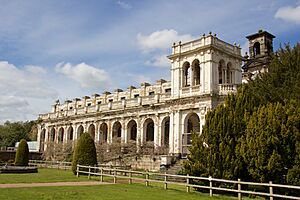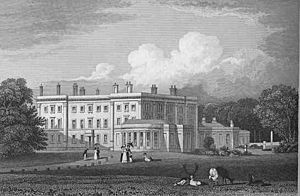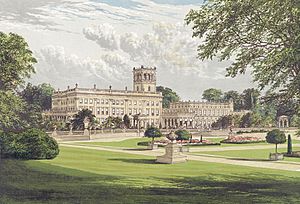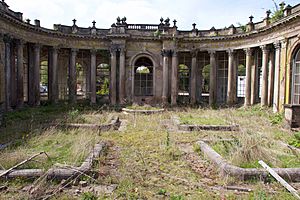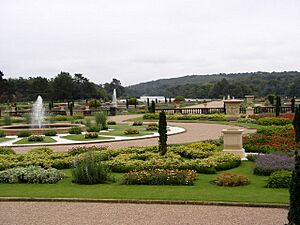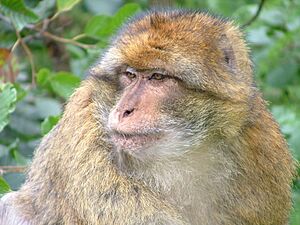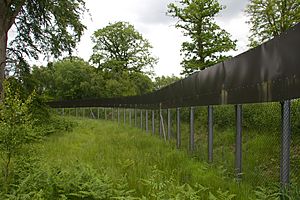Trentham Estate facts for kids
The Trentham Estate is a fun place to visit in the village of Trentham, in the city of Stoke-on-Trent, Staffordshire, United Kingdom. It has beautiful gardens, a shopping village, and even a monkey forest!
Contents
A Look Back: Trentham's History
The story of Trentham Estate began a very long time ago, in 1086, when it was first written about in the Domesday Book. Back then, it was a royal area. For many years, a special religious building called an Augustinian priory stood here. Later, it became a convent. These buildings were part of the Trentham estate until the Dissolution of the Monasteries, which was when many monasteries in England were closed down.
Trentham Hall: A Grand House
In 1540, the land was sold to James Leveson, a wool merchant. His family lived there, and Sir Richard Leveson built a new house in 1634. Later, the family changed their name to Leveson-Gower.
Around 1730, John Leveson-Gower, 1st Earl Gower, built a grand house that looked a bit like Buckingham Palace. It was changed a lot by his son, Granville Leveson-Gower, 1st Marquess of Stafford, with help from an architect named Henry Holland between 1775 and 1778.
The country house you see parts of today was designed by Charles Barry between 1833 and 1842. He was also working on the Palace of Westminster (where the Houses of Parliament are!) at the same time. The 2nd Duke of Sutherland asked him to design it. A huge clock tower, about 10,000 square feet, was a main part of the building.
The main entrance to the hall was from the west. It had a grand, Italian-style design with a semicircular shape and columns. There was also an orangery, which is a special greenhouse for growing orange trees, built in 1808.
Charles Barry spent over ten years making the house even better. He added new rooms, including bedrooms, servant areas, and a sculpture gallery. He also designed the Riding School and clock tower in 1840, which were built between 1841 and 1850. These buildings are some of the only parts of the impressive Trentham Hall that still stand today.
In 1851, people described the hall as a very "elegant mansion" with a stone front and a large collection of paintings.
The house was surrounded by a beautiful park designed by Lancelot Brown in the 1700s and 1800s. Trentham Hall was the main home in Staffordshire for the Dukes of Sutherland. They were traditionally buried nearby at Trentham Mausoleum.
In the southern part of the estate, there's a huge statue of the 1st Duke of Sutherland. This monument was built in 1834, a year after he passed away.
Why the Hall Was Demolished
Trentham Hall was one of many grand houses that were torn down in the 1900s. The River Trent used to flow near the hall, but by the early 1900s, it became very polluted with sewage from nearby pottery factories. This made living at the hall very unpleasant.
The family stopped living in the hall in 1905. They offered it to Staffordshire County Council to be used as a college, but the council said no. Then, in 1907, the Duke of Sutherland offered the estate to the six towns that would later become Stoke-on-Trent. But after they joined together in 1910, the new city also turned down the offer in 1911 because it would cost too much to keep up.
So, the 4th Duke of Sutherland decided to have the hall torn down in 1912-1913.
Even after the hall was gone, the estate was used for fun things like an amusement park. It even hosted the Lombard RAC Rally, a car race that went through the beautiful Italian gardens!
Some parts of the hall were not demolished, like the sculpture gallery, the clock tower, and the local church.
What's There Now
The parts of Trentham Hall that are left, like the Grand Entrance and the Orangery, are now protected as Grade II* listed buildings. This means they are very important historical buildings. They are also on the Heritage at Risk Register, which means they need special care to keep them from falling apart. The sculpture gallery and clock tower are still there too.
In 1996, a company called St. Modwen Properties bought the estate. The buildings and gardens were in bad shape, but the company worked hard to bring them back to life. The beautiful Trentham Gardens were restored between 2003 and 2004. By 2013, over 3 million people visited them! Today, Trentham Estate has a shopping village and amazing gardens.
St. Modwen had a plan to rebuild the hall as a fancy five-star hotel, but it was too expensive. Even though they had permission to rebuild it, they found that the cost of £30-35 million was more than the hotel would be worth, especially after the economic recession. So, as of 2015, the remaining buildings are still empty.
Trentham Gardens: A Place of Beauty
Trentham Gardens are famous for their formal Italian-style gardens and a large English landscape park. These gardens are surrounded by a big woodland, covering about 300 acres.
The gardens were first designed by Capability Brown starting in 1758. He created a winding, natural-looking park. Later, in the 1840s, Sir Charles Barry (who designed the hall) laid out the formal gardens that have been restored today. In 2012, Trentham Estate was chosen for a Royal Diamond Jubilee wood, and 200,000 new oak trees will be planted there. Famous garden designers like Tom Stuart-Smith, Piet Oudolf, and Nigel Dunnett helped redesign the gardens.
Since 2000, St. Modwen Properties has spent a lot of money (about £120 million) making Trentham Gardens a great place for fun and relaxation. They restored the Italian gardens and woodlands, and added a garden centre and craft shops. The goal is to offer "authentic experiences" for visitors, rather than noisy theme park rides. Every year on Bonfire Night, people come to see a big bonfire, fireworks, food, and fairground rides.
A large Ferris wheel was set up in 2008 so visitors could see the gardens and estate from above, but it was removed in 2009.
Mountain Biking Adventures
Trentham Gardens has also been a cool spot for mountain biking! It hosted the very first Mountain Mayhem race, which is a 24-hour mountain bike challenge. Big bike brands like Raleigh and Giant competed, along with 120 other teams. The course was almost 10 miles long.
The Raleigh Pro Team won that first race. From 2001 to 2004, other mountain bike races called Sleepless in the Saddle were also held at Trentham.
Trentham Ballroom: Music and Dance
The gardens were also home to the Trentham Ballroom, a popular dance hall that opened in 1931 and closed in 2002.
In the 1960s and 1970s, many famous bands played at Trentham Ballroom, including The Beatles, Pink Floyd, The Who, Iron Maiden, and Led Zeppelin! It was a very exciting place for music lovers.
Trentham Gardens in Music Videos
Did you know Trentham Gardens was used as a filming location for a music video? The electronic music duo Altern 8 filmed parts of their song Activ 8 there. You can see the inside and outside of the building in their video.
Trentham During Wartime
Before World War I, the Staffordshire Yeomanry, a military group, used Trentham as a summer training camp from 1909 to 1914.
During World War II, Trentham Estate became a camp for French soldiers. These soldiers included the French Foreign Legion and the Chasseurs Alpins (light mountain troops). One pilot wrote in his diary that there were "six or seven thousand men in the camp – a miracle of English organisation – in a few hours we have tents, groundsheets, cooking utensils."
By July 1940, the camp had some disagreements among the French soldiers. Some chose to leave, while others joined the Free French forces. Most of the French troops stayed at Trentham. Local people's feelings changed over time; there were complaints about deer being killed and soldiers spending too much time with local girls. By the end of the war, many soldiers were happy to leave.
Trentham Monkey Forest: A Wild Experience
As part of the estate's new life, the Trentham Monkey Forest opened in July 2005. It was the first park of its kind in England! It has 60 acres of forest where 140 Barbary macaque monkeys live and roam freely.
Visitors can walk along a 0.75-mile path through the forest. There are no barriers between you and the monkeys, but guides are there to make sure everyone stays safe. A fence surrounds the whole forest. This park is one of four owned by the de Turckheim family; the others are in France and Germany. The forest is open to visitors most of the year.
There are two groups of 70 macaques, and they came from other parks in France and Germany. The oldest monkey is about 30 years old! Each macaque has a small tattoo to help identify them.
One important goal of the Monkey Forest is to help people learn about this endangered species. They also work to protect the monkeys' gene pool and even re-introduce groups of macaques back into the wild. So far, 591 macaques from the sister parks have been released into the Atlas Mountains in Morocco. The forest also helps with research into how these monkeys live and behave.
|


